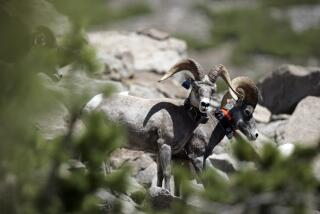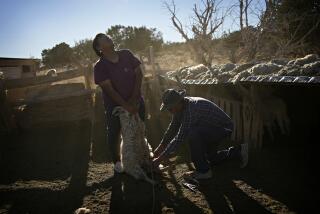Rancher Bullish About Bison
- Share via
JORDAN VALLEY, Ore — JORDAN VALLEY, Ore. -- The West may have been tamed, but life is still a little wild at Matthew and Jozet Bowen’s bison ranch on the Idaho border.
An average of a dozen vehicles a day screech their brakes and stop to look at his humpbacked animals, which are as American as the buffalo nickel.
“It’s an impressive sight, all 500 of them,” he said.
Bowen shifted from raising cattle to bison a year and a half ago. A lot of people are taking them up as a hobby or profession, which has driven down the price of the lean meat. But Bowen’s enterprise is actively marketing the animals, and he is bullish about the industry’s future.
“It pays the bills better than cows ever did,” he said.
To begin, the American buffalo is not a true buffalo. It is very close genetically to domestic cattle. True buffalo include the African Cape buffalo or Asian water buffalo.
Bison are the largest land mammal in North America since the end of the Ice Age. Estimates of the pre-European herd size vary from 30 million to 70 million.
The National Bison Assn. industry group said unregulated killing led to the endless migrating herds being reduced to no more than 1,500 individuals by the late 1800s. But their numbers have rebounded to more than 350,000, and they are found in every state, including Hawaii.
Bison have become popular among consumers because of the nostalgia and because the meat is lower in fat, calories and cholesterol than beef, pork or skinless chicken. It also provides plenty of iron and minerals.
Bowen helped raise some and decided to acquire a herd.
A lot of people thought the same way. Bowen said many of the bison sold in recent years have gone from producer to producer to build their herds.
With the numbers of buffalo around today, the price has fallen from an average of about $2,000 per animal to between $200 and $500 per animal. Retail bison goes for about $3 per pound for hamburger, $9 for top sirloin to $18 for tenderloin.
Bowen is doing what he can to move his product. An associate is often on the road marketing the animals. He also makes buffalo jerky.
And Bowen offers hunting for bison on a large expanse of deeded land adjacent to his pastures. Hunters pay to shoot a bull, which provides them with an impressive wall mount, a robe or tanned hide, and a lot of steaks for the freezer.
Buffalo have lived on the range for eons and are easy on the land. While cattle rarely stray far from water and compress the ground around a water tank or creek, buffalo water about once a day and then wander off.
The best time to obtain a full buffalo robe is December to February. By late spring, the remains of the robe resemble brown lint and the bison roll on the ground to rid themselves of it.
Bowen’s herd is accustomed to him, so he can work and drive his truck near them. But they remain wild animals and are extremely protective of their cinnamon-colored calves. An irritated bull -- which can weigh up to a ton -- can outrun a horse over a short distance, meaning that even the most seasoned bison rancher is loathe to turn his back on the creature.
Buffalo do roam. Hang around the pasture and they will have moved 200 yards in 10 minutes. Bowen rotates them around several pastures. His biggest job is making sure his fences are in good repair. A bull can make a standing six-foot jump.
“As long as they can move, they’re fine. The time they get difficult is in a corral. They don’t like that closed-in feeling,” he said.
Bison numbers are booming through the livestock industry, on cable television mogul Ted Turner’s preserves and on some Indian reservations.
Conservationists are battling with federal agencies and the state of Montana to preserve what bison advocates consider the nation’s last wild herd -- in Yellowstone National Park.
Ranchers contend that bison with brucellosis can spread the disease to cattle and jeopardize Montana’s beef industry. Bison advocacy groups such as Buffalo Field Campaign and Cold Mountain, Cold Rivers claim that a few cattlemen have prompted the government to haze and slaughter Yellowstone bison as they migrate to their historic wintering and calving grounds in the national park.
Bowen said Jordan Valley residents have a long tradition of raising cattle and have their qualms about any livestock without the “white face and red coat” of a Hereford cow.
But the Bowen children love their animals, including birds, a pig and 500 buffalo.
Bowen likes the simplicity of his herd.
“Grass, water and room. That’s all they need,” he said.
More to Read
Sign up for Essential California
The most important California stories and recommendations in your inbox every morning.
You may occasionally receive promotional content from the Los Angeles Times.













